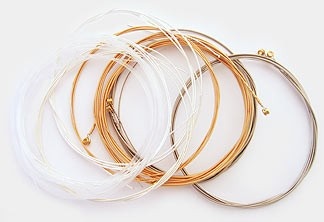Restringing your Guitar
Strings come in sets of six, or as single strings and they come in different gauges, or thicknesses. Thinner ("lighter") strings are easier on the fingers and easier to bend as they require less tension to bring them up to pitch, but are quieter than thicker ("heavier") strings. This is especially noticeable on acoustic guitars, so if you want volume, buy heavier strings ...▼

Now that you're a guitarist, you're going to be spending a lot of time restringing your guitar. Unfortunately, strings don't last forever; they can break, especially if you strum them hard, but they also just wear out. You'll know it when they do because they start to lose their ringing sound, they become dull, and if you leave them on for a long time, they can rust and/or become impossible to tune properly.
How long does a set of strings last? That depends on many factors, but you should be able to get at least a couple of months out of a set of strings. If you play often and play hard, obviously string-fatigue will set in early. Body chemistry is a big factor: if your sweat is acidic, you'll notice that steel strings blacken, lose their shine and eventually break. If that's the case, make sure you wipe the strings down with a cloth whenever you've finished playing. If your chemistry is string-friendly, you can get a lot more life out of your strings but eventually you'll hear that they have lost their twang.
There's nothing like the sound of a fresh set of strings so the more often you can change them, the more satisfaction you (and your audience) will get out of playing.
The cost of strings varies from country to country and often is the main reason players leave their strings on long after their use-by date but the Internet has come to the rescue as buying strings online is by far the cheapest way, especially if you buy them in bulk. Do a quick search and you'll see what I mean.
Nylon strings are not so prone to breaking as they're not strummed with a flat pick (or at least are not meant to be). You'll find that the metal windings on the three bass strings show the first signs of wear and tear and when they finally give way, you'll probably want to change them, as it feels awful to run your fingers along strings with gaps in the winding. They also sound dull and lifeless.
Changing them is not difficult. Nylon strings need to be tied to the bridge with a simple knot and steel strings are pinned into the bridge with wooden or plastic bridge pins. Watch the movies to see how I do it.
Strings take a while to stretch and need to be tightened back up several times before they settle in. This applies especially to nylon strings. (See Tuning your guitar for more on that).

Join Our Free Trial
Get started today before this once in a lifetime opportunity expires.
